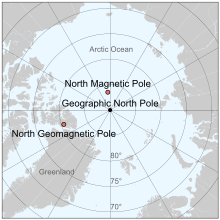
The north magnetic pole, also known as the magnetic north pole, is a point on the surface of Earth's Northern Hemisphere at which the planet's magnetic field points vertically downward (in other words, if a magnetic compass needle is allowed to rotate in three dimensions, it will point straight down). There is only one location where this occurs, near (but distinct from) the geographic north pole. The geomagnetic north pole is the northern antipodal pole of an ideal dipole model of the Earth's magnetic field, which is the most closely fitting model of Earth's actual magnetic field.
The north magnetic pole moves over time according to magnetic changes and flux lobe elongation[2] in the Earth's outer core.[3] In 2001, it was determined by the Geological Survey of Canada to lie west of Ellesmere Island in northern Canada at 81°18′N 110°48′W / 81.300°N 110.800°W.[4] It was situated at 83°06′N 117°48′W / 83.100°N 117.800°W in 2005. In 2009, while still situated within the Canadian Arctic at 84°54′N 131°00′W / 84.900°N 131.000°W,[5] it was moving toward Russia at between 55 and 60 km (34 and 37 mi) per year.[6] In 2013, the distance between the north magnetic pole and the geographic north pole was approximately 800 kilometres (500 mi).[7] As of 2021, the pole is projected to have moved beyond the Canadian Arctic to 86°24′00″N 156°47′10″E / 86.400°N 156.786°E.[8][5]
Its southern hemisphere counterpart is the south magnetic pole. Since Earth's magnetic field is not exactly symmetric, the north and south magnetic poles are not antipodal, meaning that a straight line drawn from one to the other does not pass through the geometric center of Earth.
Earth's north and south magnetic poles are also known as magnetic dip poles, with reference to the vertical "dip" of the magnetic field lines at those points.[9]
| Year | 1990 (definitive) | 2000 (definitive) | 2010 (definitive) | 2020 |
|---|---|---|---|---|
| North magnetic pole | 78°05′42″N 103°41′20″W / 78.095°N 103.689°W | 80°58′19″N 109°38′24″W / 80.972°N 109.640°W | 85°01′12″N 132°50′02″W / 85.020°N 132.834°W | 86°29′38″N 162°52′01″E / 86.494°N 162.867°E |
| South magnetic pole | 64°54′36″S 138°54′07″E / 64.910°S 138.902°E | 64°39′40″S 138°18′11″E / 64.661°S 138.303°E | 64°25′55″S 137°19′30″E / 64.432°S 137.325°E | 64°04′52″S 135°51′58″E / 64.081°S 135.866°E |
- ^ "Magnetic North, Geomagnetic and Magnetic Poles". wdc.kugi.kyoto-u.ac.jp. Retrieved 18 December 2019.
- ^ Livermore, Philip W.; Finlay, Christopher C.; Bayliff, Matthew (2020). "Recent north magnetic pole acceleration towards Siberia caused by flux lobe elongation". Nature Geoscience. 13 (5): 387–391. arXiv:2010.11033. Bibcode:2020NatGe..13..387L. doi:10.1038/s41561-020-0570-9. S2CID 218513160. Archived from the original on 14 June 2020. Alt URL
- ^ Merrill, Ronald T.; McElhinny, Michael W.; McFadden, Phillip L. (1996). "Chapter 8". The magnetic field of the earth: paleomagnetism, the core, and the deep mantle. Academic Press. ISBN 978-0-12-491246-5.
- ^ Wei-Haas, Maya (4 February 2019). "Magnetic north just changed. Here's what that means". Science & Innovation. National Geographic. Archived from the original on 4 February 2019. Retrieved 5 February 2019.
- ^ a b World Data Center for Geomagnetism, Kyoto. "Magnetic North, Geomagnetic and Magnetic Poles". Retrieved 3 July 2012.
- ^ North Magnetic Pole Moving East Due to Core Flux, National Geographic, 24 December 2009
- ^ Petrovich Dubrov, Aleksandr (11 November 2013). The Geomagnetic Field and Life. Springer US. p. 12. ISBN 9781475716108.
- ^ NP.xy
- ^ "The Magnetic North Pole". Ocean bottom magnetology laboratory. Woods Hole Oceanographic Institution. Archived from the original on 19 August 2013. Retrieved 6 February 2017.
- ^ Cite error: The named reference
NGDC_WANDwas invoked but never defined (see the help page).